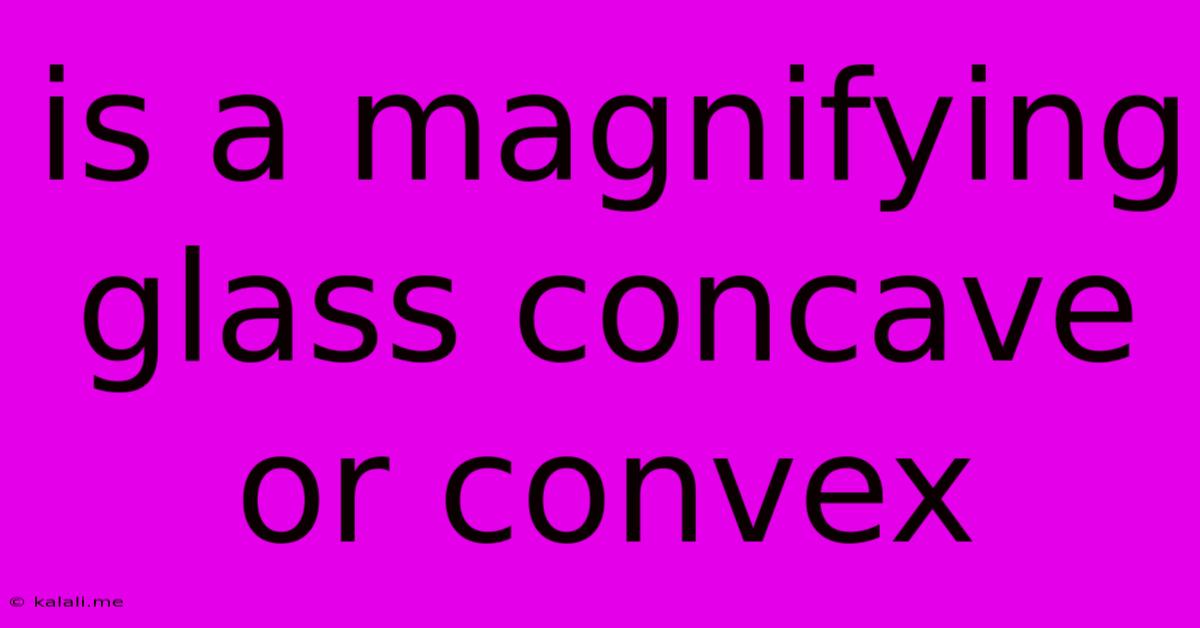Is A Magnifying Glass Concave Or Convex
Kalali
Jun 13, 2025 · 2 min read

Table of Contents
Is a Magnifying Glass Concave or Convex? Understanding Lenses and Magnification
A magnifying glass is a convex lens. Understanding why requires a brief dive into the world of optics and lens types. This article will explain the difference between concave and convex lenses, how they affect light, and why a magnifying glass uses a convex lens to achieve magnification. We'll also explore some common misconceptions and applications of these different lens types.
What are Convex and Concave Lenses?
Lenses are transparent objects, usually made of glass or plastic, that refract (bend) light. They are categorized based on their shape:
-
Convex lenses: These lenses are thicker in the middle than at the edges. Think of a magnifying glass – that’s the classic example of a convex lens. The curvature of the lens causes light rays to converge (come together) at a point called the focal point.
-
Concave lenses: These lenses are thinner in the middle than at the edges. They diverge (spread out) light rays. You'll often find concave lenses in things like corrective eyeglasses for nearsightedness.
How a Magnifying Glass Works: The Power of Convex Lenses
A magnifying glass uses a convex lens to magnify images. When light passes through a convex lens, it bends towards the center, converging at the focal point. This creates a larger, virtual image of the object being viewed. The closer the object is to the lens, the larger the magnified image will appear. The magnification achieved depends on the curvature of the lens; a more strongly curved lens will provide greater magnification.
Why Not Concave Lenses?
Concave lenses diverge light rays, making the image appear smaller and farther away. This is the opposite effect of what a magnifying glass is designed to do. While concave lenses have their uses (like in eyeglasses for nearsightedness), they are not suitable for magnifying objects.
Common Misconceptions
It’s important to clarify a common misconception: Some people mistakenly believe the magnifying effect is due to the lens simply bringing the object closer. This isn't entirely accurate; while being closer to the object increases the size of its image on the retina, the true magnifying effect comes from the refraction of light caused by the convex lens. This is crucial for magnifying very small details beyond what's physically achievable with simply moving closer.
Applications of Convex and Concave Lenses
Beyond magnifying glasses, both convex and concave lenses have wide-ranging applications:
- Convex lenses: Cameras, telescopes, microscopes, eyeglasses for farsightedness.
- Concave lenses: Eyeglasses for nearsightedness, some types of telescopes (used for correcting optical aberrations).
In Conclusion:
To reiterate, a magnifying glass is definitively a convex lens. Its convex shape bends light rays to converge, creating a magnified, virtual image of the object. Understanding the differences between convex and concave lenses is key to grasping the principles behind many optical devices we use daily.
Latest Posts
Latest Posts
-
Choose All True Statements About The Activity Of Mpf
Jun 14, 2025
-
First A Price Was Decreased By 12
Jun 14, 2025
-
California State University Northridge Admission Requirements
Jun 14, 2025
-
Distinguish Between Consumer Goods And Capital Goods
Jun 14, 2025
-
Which Of The Following Is A Good Conductor Of Heat
Jun 14, 2025
Related Post
Thank you for visiting our website which covers about Is A Magnifying Glass Concave Or Convex . We hope the information provided has been useful to you. Feel free to contact us if you have any questions or need further assistance. See you next time and don't miss to bookmark.